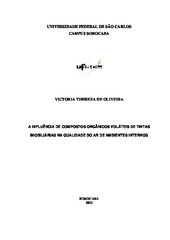| dc.contributor.author | Oliveira, Victoria Thereza de | |
| dc.date.accessioned | 2023-04-11T17:05:21Z | |
| dc.date.available | 2023-04-11T17:05:21Z | |
| dc.date.issued | 2023-03-22 | |
| dc.identifier.citation | OLIVEIRA, Victoria Thereza de. A influência de compostos orgânicas voláteis de tintas imobiliárias na qualidade do ar de ambientes internos. 2023. Trabalho de Conclusão de Curso (Graduação em Química) – Universidade Federal de São Carlos, Sorocaba, 2023. Disponível em: https://repositorio.ufscar.br/handle/ufscar/17699. | * |
| dc.identifier.uri | https://repositorio.ufscar.br/handle/ufscar/17699 | |
| dc.description.abstract | Considering that people have spent most of their time indoors, it becomes essential to
identify the quality of the air they are exposed to during this period. In this context, there
are several sources and types of pollutants for indoor air, volatile organic compounds
standing out as the most relevant class of these pollutants. The present study aimed to
evaluate volatile organic compounds in architectural paints, which is present in the majority
of homes, and their influence on indoor air quality. For this, through a bibliographic review
in the Web of Science and ScienceDirect database, 21 articles were selected for the
investigation the composition of the air in residences in different countries, the volatile
organic compounds found attributed to architectural paints and the influence of the
residents' health. In that way, it was found that newly painted homes have higher levels of
volatile organic compounds, up to 4% of the volatiles found in air samples from homes can
be attributed to paints and their main volatiles such as xylene and ethylbenzene. In addition,
it was identified as an effect to the great exposure of inhabitants of houses with low indoor
air quality, diseases such as the sick building syndrome. | eng |
| dc.description.sponsorship | Não recebi financiamento | por |
| dc.language.iso | por | por |
| dc.publisher | Universidade Federal de São Carlos | por |
| dc.rights | Attribution-NonCommercial-NoDerivs 3.0 Brazil | * |
| dc.rights.uri | http://creativecommons.org/licenses/by-nc-nd/3.0/br/ | * |
| dc.subject | Compostos Orgânicos Voláteis | por |
| dc.subject | Tintas Imobiliárias | por |
| dc.subject | Qualidade de Ar Interno | por |
| dc.subject | Volatile Organic Compound | eng |
| dc.subject | Architecture Paints | eng |
| dc.subject | Indoor Air Quality | eng |
| dc.title | A influência de compostos orgânicas voláteis de tintas imobiliárias na qualidade do ar de ambientes internos | por |
| dc.title.alternative | The influence of volatile organic compounds from Architecture paints in the air quality of indoor environments | eng |
| dc.type | TCC | por |
| dc.contributor.advisor1 | Oliveira, Luciana Camargo de | |
| dc.contributor.advisor1Lattes | http://lattes.cnpq.br/6238603150964753 | por |
| dc.description.resumo | Tendo em vista que as pessoas têm passado a maior parte de seu tempo dentro de suas casas, se
torna essencial identificar a qualidade do ar no qual estão expostas durante esse período. Neste
contexto, diversas são as fontes e os tipos de poluentes para o ar de interiores, sendo que os
compostos orgânicos voláteis se destacam como a classe mais relevante desses poluentes.
Assim, o presente estudo teve como objetivo avaliar os compostos orgânicos voláteis oriundos
de tintas imobiliárias, a qual está presente na grande maioria das residências, e sua influência
na qualidade do ar de ambientes internos. Para isso, realizou-se uma revisão bibliográfica nas
bases de dados Web of Science e ScienceDirect, selecionando-se 21 artigos para a investigação
da composição do ar de residências de diferentes países, os compostos orgânicos voláteis
encontrados atribuídos às tintas imobiliárias e a influência na saúde dos moradores. Diante
disso, verificou-se que residências recém pintadas apresentam maiores índices de compostos
orgânicos voláteis, até 4% dos voláteis encontrados em amostras de ar de residências podem
ser atribuídos às tintas, sendo os principais voláteis o xileno e tolueno. Além disso, foi
identificado como efeito à grande exposição de habitantes de casas com baixa qualidade de ar
interno, doenças como a síndrome do edifício doente. | por |
| dc.publisher.initials | UFSCar | por |
| dc.subject.cnpq | CIENCIAS EXATAS E DA TERRA::QUIMICA::QUIMICA ANALITICA::ANALISE DE TRACOS E QUIMICA AMBIENTAL | por |
| dc.publisher.address | Câmpus Sorocaba | por |
| dc.publisher.course | Química - QL-So | por |

